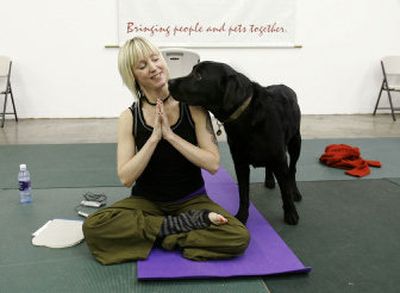Yoga classes help dogs relax

BELLEVUE, Wash. – By the end of their doggie yoga class, most of the wandering and sniffing participants are passed out on their mats, in a position their instructor calls the “upward-facing belly pose.”
Beans, a 2-year-old Vizsla, however, is ready to play. The overgrown puppy has tried to relax with his owner, Chantale Anderson, but once Magnet the black Lab heads off to explore the room, Beans is ready to go.
Mostly, however, both the dogs and the humans on a recent evening at the Seattle/King County Humane Society seemed relaxed and focused for about 40 minutes of “doggie yoga.”
Leilani the toy poodle is the star of the class, perhaps because the tiny 11-year-old is too timid to venture off the mat to play with the big dogs.
Her owner, Suanne Nagata, said afterward that Leilani just loves being touched.
“I could just feel her relax,” she said.
Brenda Bryan, who teaches human yoga as well as the new class for both dogs and humans at the Humane Society, says the dogs react to the gentle energy in the room.
“As we get into it, the dogs all kind of calm down,” said Bryan, who developed the poses for the class by working with her own two dogs – Gus, a mixed breed, and Honey, a Shar Pei-Boxer mix – and talking to instructors in other cities like New York, Los Angeles and Pittsburgh where yoga for dogs and their owners is starting to catch on.
The question she and the Humane Society get the most from prospective human students is, how do the people and dogs interact?
In Bryan’s class, the humans do traditional yoga poses – yes, including “downward-facing dog” – while staying in contact physically with their pets.
Part of the class includes gentle stretching and dog massage, another specialty of Bryan’s, but most of the time the humans gently use the dogs like yoga props.
In downward-facing dog, for example, the humans rest their heads on their companions, who are relaxing – napping? – on the mat.
The yoga poses are modified both for the humans of different sizes and abilities and for the dogs. During class, Bryan reminds the people not to push their canine partners to perform.
“Don’t be too ambitious,” she said. “Honor where your dog is and remember that dogs respond to our energy.”
Bryan calls the class “partner yoga,” because the class encourages both the human and the dog to increase their awareness of each other.
“Magnet and I were just in this little bubble,” said Emily Keegans afterward.
She said her dog really loves getting the one-on-one attention he receives in yoga class and she likes having another opportunity to both exercise and spend time with her dog.
Bryan said she was doing dog massage at a Humane Society fundraiser when, during a conversation with the agency director, she mentioned that she is also a yoga instructor. And the idea for doggie yoga was born.
“It was really just a marriage of all the things I love,” Bryan said.
Both the humans and the canines seemed to enjoy themselves before, during and after a recent doggie class at the Humane Society.
Shadow visited every mat during the class and made a complete circuit of shoe-sniffing toward the end. Beans seemed a lot more interested in making new friends than relaxing, as his owner predicted before the class.
“He likes to nap. He is a cuddle bug, but playing is so much more important,” Anderson said.
Nearly every dog in the group took at least one break to sniff a canine or human or both, but Bryan seemed pleased with how the class was going and was neither outwardly amused nor flustered when Honey and Shadow crowded onto the mat with her and Gus. Although her voice was yoga calm, her words showed she shared the other humans’ amusement.
“Everyone is being so good – and the dogs too.”